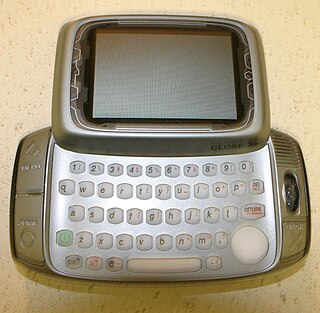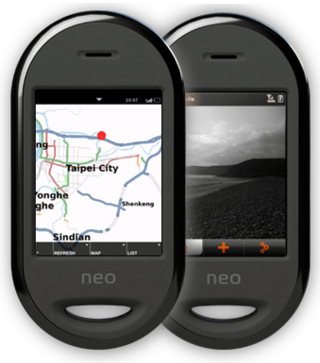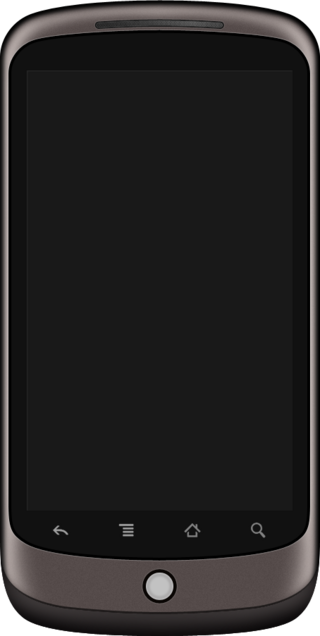
The Danger Hiptop, also re-branded as the T-Mobile Sidekick, Mobiflip and Sharp Jump is a GPRS/EDGE/UMTS smartphone that was produced by Danger, Inc. from 2002 to 2010.

Near-field communication (NFC) is a set of communication protocols that enables communication between two electronic devices over a distance of 4 cm (1.57 in) or less. NFC offers a low-speed connection through a simple setup that can be used to bootstrap more capable wireless connections. Like other "proximity card" technologies, NFC is based on inductive coupling between two so-called antennas present on NFC-enabled devices—for example a smartphone and a printer—communicating in one or both directions, using a frequency of 13.56 MHz in the globally available unlicensed radio frequency ISM band using the ISO/IEC 18000-3 air interface standard at data rates ranging from 106 to 848 kbit/s.

Windows Mobile was a family of mobile operating systems developed by Microsoft for smartphones and personal digital assistants.

Linux-based devices or Linux devices are computer appliances that are powered by the Linux kernel and possibly parts of the GNU operating system. Device manufacturers' reasons to use Linux may be various: low cost, security, stability, scalability or customizability. Many original equipment manufacturers use free and open source software to brand their products. Community maintained Linux devices are also available.

Tethering or phone-as-modem (PAM) is the sharing of a mobile device's Internet connection with other connected computers. Connection of a mobile device with other devices can be done over wireless LAN (Wi-Fi), over Bluetooth or by physical connection using a cable, for example through USB.

Openmoko is a discontinued project to create a family of open source mobile phones, including the hardware specification, the operating system, and actual smartphone development implementation like the Neo 1973 and Neo FreeRunner. The whole project was sponsored by Openmoko Inc.

The HTC TyTN II is an Internet-enabled Windows Mobile Pocket PC smartphone designed and marketed by HTC Corporation of Taiwan. It has a tilting touchscreen with a right-side slide-out QWERTY keyboard. The TyTN II's functions include those of a camera phone and a portable media player in addition to text messaging and multimedia messaging. It also offers Internet services including e-mail, instant messaging, web browsing, and local Wi-Fi connectivity. It is a quad-band GSM phone with GPRS, EDGE, UMTS, HSDPA, and HSUPA.

Android is a mobile operating system based on a modified version of the Linux kernel and other open-source software, designed primarily for touchscreen mobile devices such as smartphones and tablets. Android is developed by a consortium of developers known as the Open Handset Alliance, though its most widely used version is primarily developed by Google. It was unveiled in November 2007, with the first commercial Android device, the HTC Dream, being launched in September 2008.

The Nexus One is an Android smartphone designed and manufactured by HTC as Google's first Nexus smartphone. The Nexus became available on January 5, 2010, and features the ability to transcribe voice to text, an additional microphone for dynamic noise suppression, and voice guided turn-by-turn navigation to drivers.

The Samsung SGH-i900, also known as Omnia I or WiTu, is a smartphone created by Samsung Mobile. Announced in June 2008, the Omnia was launched in Singapore in mid-June, available in stores on the 20th of June, and in the rest of Asia in July. For some parts of Europe, it was launched in August. It was made available for the United States in December 2008 through Verizon Wireless and for Canada in April 2009 through Telus Mobility.

The HTC Dream is a smartphone developed by HTC. First released in September 2008, the Dream was the first commercially released device to use the Linux-based Android operating system, which was purchased and further developed by Google and the Open Handset Alliance to create an open competitor to other major smartphone platforms of the time, such as Symbian, BlackBerry OS, and iPhone OS. The operating system offers a customizable graphical user interface, integration with Google services such as Gmail, a notification system that shows a list of recent messages pushed from apps, and Android Market for downloading additional apps.
The Android Dev Phone (ADP) is a SIM-unlocked and bootloader unlocked Android device that is designed for advanced developers. While developers can use regular consumer devices purchased at retail to test and use their apps, some developers may choose not to use a retail device, preferring an unlocked or no-contract device.

HTC Hero is the third phone manufactured by HTC running the Android platform, announced on June 24, 2009 in London.

The HTC Legend is a phone manufactured by HTC Corporation in Taiwan for the Android platform. It was unveiled by HTC during the Mobile World Congress in Barcelona on 16 February 2010 and went on sale on 10 March 2010.
Rooting is the process by which users of Android devices can attain privileged control over various subsystems of the device, usually smartphones. Because Android is based on a modified version of the Linux kernel, rooting an Android device gives similar access to administrative (superuser) permissions as on Linux or any other Unix-like operating system such as FreeBSD or macOS.

GeeksPhone was a Spanish smartphone company founded in 2009. GeeksPhone's most notable products are open Android phones and developer devices of Firefox OS.

The Motorola DROID 3 is a smartphone released on July 7, 2011, by Verizon Wireless running the Android 2.3 operating system by Google. It comes with 16 GB of internal storage. The smartphone does not ship with a microSD card. It has a 4-inch qHD display and an 8-megapixel camera capable of recording 1080p video. Unlike the DROID 2, the Motorola DROID 3 features a 5-row QWERTY keyboard, with a dedicated number row. It also has a VGA front-facing camera for video calls. The Droid 3 ships with Android 2.3.4 (Gingerbread) with Motorola's updated proprietary Motoblur UI. Like other contemporary Motorola phones, it has a locked bootloader, but it can have a custom rom using SafeStrap.

The GeeksPhone Peak is a low-end smartphone released by GeeksPhone in April 2013. It is intended for software developers wanting to build and test mobile applications on the new Firefox OS, not for general consumers.















